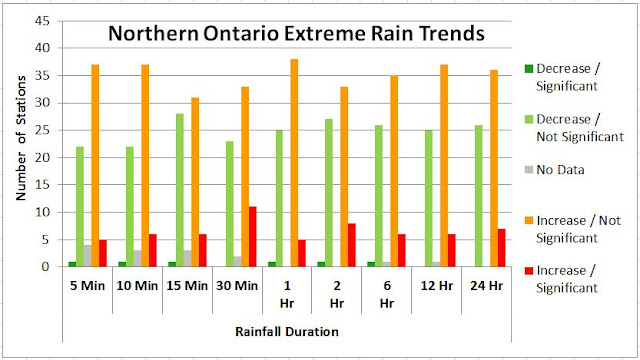Its also is great that the insurance industry, who had input the the PBO report, is no longer saying rainfall intensities are increasing across the country due to climate change and causing flooding. But the report notes on page 26 under Effects of Climate Change:
"One last factor, which is likely affecting the intensity of floods in the Prairie Provinces, is climate change. The warming in the arctic has been associated with persistent weather systems in the mid-latitudes as well as extreme weather events. Consistent with this, multiple-day rain events have significantly increased in the Prairie Provinces and in the Rockies. The recent record setting multiple-day rainfalls in south-eastern Saskatchewan in 2010 and 2014 are likely examples."
What does Environment and Climate Change Canada data show about the intensity of multi-day rainfall? They don't publish multi-day statistics in the Engineering Climate Dataset but they do track trends up to the 24 hour periods - we can look at those as an indicator of longer duration trends:
 |
| Engineering Climate Dataset Version 2.3 - 24 Hour Rainfall Trends and Statistical Significance. |
 |
| Saskatoon - significant decrease in 24 hour rain. |
 |
| Davin 5 - significant decrease in 24 hour rain. |
Note that short duration climate records can have an upward bias in trends that is not related to underlying changes (like due to climate) because the probability distribution of rainfall extremes is skewed (minimum bound of zero and long 'right tail' extreme events). To look past this statistical sampling bias, we can review longer record climate stations. The following table shows trends for Manitoba, Saskatchewan, Alberta and British Columbia stations with more than 25 years of record, observations since 2000, and locations east of longitude 120 degrees west (about east of Kamloops) to avoid the coast (note table is updated).
The table of long term stations with recent data shows the following:
 |
| Buffalo Narrows Airport climate station - consistent decrease in annual maximum rainfall over all durations. |
- British Columbia trends show more increases than decreases for the 24 hour period (9 vs. 2). Blue River Airport is the only station with a statistically significant increase in 24 hour rainfall trend out of all 39 long term recent stations in the area of interest.
- Alberta trends are more evenly up and down over 24 hours (5 vs. 3), but shorter durations of 2, 6, and 12 hours have decidedly more decreasing observed intensities.
- Saskatchewan has more decreasing intensities than increases over 24 hours but a near even split (6 vs. 5) - like Alberta, shorter durations have more decreases.
- Manitoba has more increases than decreases (6 vs. 3) over 24 hour periods.
 |
| Weyburn climate station - consistent decrease in annual maximum rainfall over all durations. |
The map below includes the south eastern Saskatchewan area that the PBO report notes has had "recent record setting multiple-day rainfalls". The 24 hour rainfall trends do not show increases in observed rainfall trends, however this may not account for the noted 2014 event. It is unlikely that the PBO report statement "multiple-day rain events have significantly increased in the Prairie Provinces" is accurate. Long duration increases are more prevalent in eastern British Columbia and Manitoba, while Alberta and Saskatchewan have mixed trends including downward and upward intensities.
The problem with the PBO report is that it seems to make the common mistake in rain intensity reporting - i.e., that the plural of anecdote = data. Of course it does not equate to data, and so two events should not be cited as the rationale for identifying significant trends. Citing two storms to make a trend conclusion demonstrates the "availability bias" in reactionary thinking that we have explored previously. Evidence-based policies for flood risk mitigation will require Kahneman's System 2 thinking with detailed, methodical analysis and not "anecdotal statistics".
Single events, even record-setting ones do not necessarily change rainfall trends. Recently the July 8, 2013 storm set record rainfall amounts in Mississauga, Etobicoke and west Toronto areas. Despite this record, the statistical trend is downward for the Pearson Airport climate station, as shown in the following graph:
 |
| Recent record events do not necessarily define trends. |
Apparently for many one data point is enough for a theory.
For the PBO report, two data points can define a significant trend across an entire region, skipping over mounds of data in between.



















